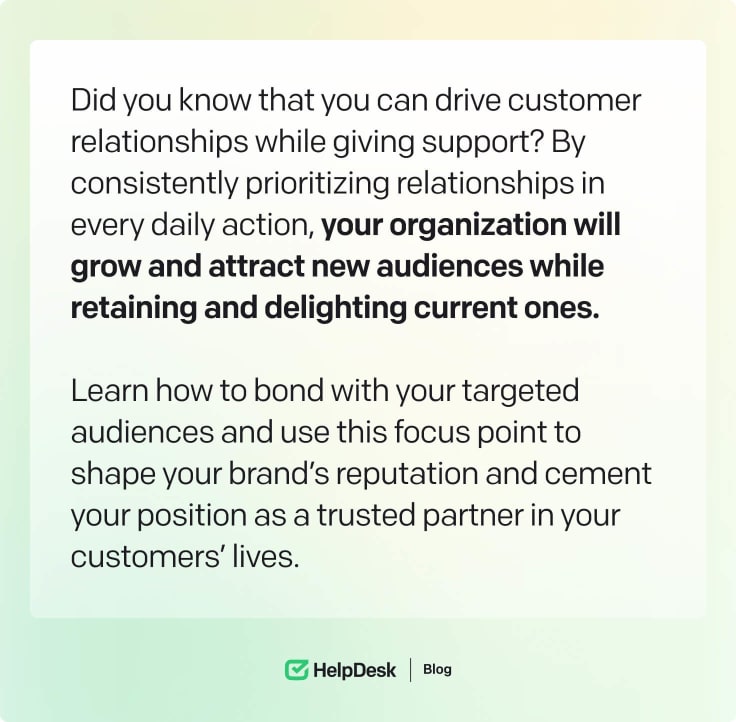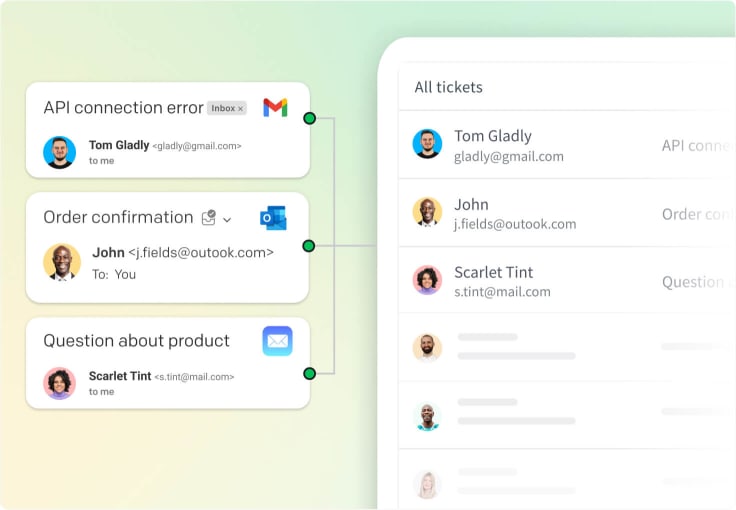Customer relationships should be one of the most important aspects of any company. After all, without customers, there would be no business! While it can be easy to overlook them in favor of other uses of your budget, the benefits of positive customer relationships offer a great return on investment.
So, how do you build strong customer relationships? Let’s find out.
Understanding customer relationships
In short, customer relationships refer to the interactions between a business and its customers. Their foundation is the connection between a company and those who use its service or buy its products.
Unsurprisingly, it’s an entirely transactional relationship that necessitates a company:
-
Offering high-quality products or services that customers want to buy.
-
Marketing to its target audience in a way that appeals to them.
-
Providing ways for a customer to interact with the business, whether on social media or by leaving reviews.
It can be challenging to shift from simply offering a product and assuming people will want it. Still, the difference made by focusing on managing customer relationships and relations can be massive.
Why are customer relationships meaningful?
It should be obvious why customer relationships are essential to a company. Without customers, a business would not succeed at its most fundamental goal: making money.
Of course, a company might still make some sales even if it doesn’t care about its customers, but it will be at a lower scale than it wants.
In addition to simply selling to customers, several other aspects help maintain customer relationships. These are satisfaction, loyalty, and retention.
Put simply, customers who have a great experience with a business are 3.5 times more likely to come back (source). Similarly, happy customers are 70% more likely to recommend a company to friends and family and are 92% more likely to trust someone’s recommendation than marketing alone (source).
It has a positive impact on the business, too. Customers who feel satisfied and loyal will remember their experience and are happier to give their money to a company.
In turn, the business will see increased revenue and customer retention. A good reputation can be a competitive advantage even in the most saturated niches.
Learn more about customer retention thanks to our Learning Space Guide. Check it out right now! 🚀

Building positive customer relationships
So, if building positive customer relations is so fundamental for a company’s success, how does it make them? While it can be a relatively passive process if your product is sellable, it’s worth proactively building positive relationships with customers and consistently using their feedback to improve.
Strategies for successful customer interactions
1. Focus on customer service
It’s a no-brainer, but the first step should be to ensure you’re offering your customers the best service possible. You aim to ensure they walk away with a positive experience and see your interaction as successful.
Of course, this looks different for all companies, depending on your product or service, sales platform, customer relations, and industry. But some general points for providing excellent customer service include:
-
Understand their problems. What issues do your customers face when they come to you? Know the answers and how your company can solve them.
-
Be knowledgeable. Know your niche. Be prepared to be asked questions, and make sure everyone knows the answers.
-
Have contingency plans. See what you can offer if a customer wants something you currently don’t have.
Customers should feel valued from the moment they first interact with your business. Consider how you market to them, how you speak to them, and what you expect them to get from your company
2. Invest in training
Employees should receive training on how customer relations representatives appropriately interact with customers. You should already have a program in place that explains the basics. If not, implement one immediately or hire an external training provider.
Proper employee training will include topics such as how to speak to customers, sell, overcome objections, and much more. The bottom line is that employees should think customer-centric when acting on behalf of their company.
Discover how to train your employees. 📚Read the HelpDesk article about it and boost your client's satisfaction and loyalty!

3. Use a CRM platform
A customer relationship management (CRM) platform allows a company to centralize and track customer relationships. The software aims to turn these interactions into data, which can then be analyzed to identify trends and improve service.
Your CRM platform should work with the business you run. Ideally, it’ll include features like chatbots and email integration while pulling data from phone calls, contact forms, and messages. CRM software is designed to consolidate all customer interactions into a single location.
A platform like Help Desk does this precisely. You can use it to monitor customer data, set up a ticketing system, and more. CRM tools help you offer more to your customers with greater ease.

The easiest help desk system for a team like yours
Discover HelpDesk
4. Collect and act on customer feedback
As mentioned, customer feedback is essential to building positive customer relationships. People feel heard if they can submit their thoughts, whether as a product or service review, a complaint, a support ticket, or any other option you can offer.
Similarly, if you can demonstrate that you act on customer complaints and feedback, you’ll add value beyond increased profits. Acting on feedback shows that you’re a customer-centric business that understands customers’ needs and prioritizes their expectations.

Measuring and improving customer satisfaction
Now that you have obtained valuable data, the next step is to use it to continuously enhance your customer service team. To start, pinpoint the areas you wish to monitor and transform them into key performance indicators (KPIs) and strategies to achieve them.
Use metrics like customer satisfaction (CSAT), net promoter score (NPS), and customer effort score (CES) to gain a comprehensive understanding of your customer’s journey. These metrics track various aspects of positive customer relationships, such as the ease of interacting with your product or service and the likelihood of customers recommending you.
Once you have gathered enough data, establish strategies to enhance customer satisfaction. Nearly every aspect can be transformed into a data point, which can then be used to create a KPI. Use these KPIs as a foundation for continuously monitoring and improving customer service.
Creating a customer-centric culture
Improving your customer service is just one part of the bigger picture. You should also foster a customer-centric culture at your business that prioritizes their needs and expectations above all else. Your customers should receive excellent service while also feeling valued.
Developing a customer-focused mindset
First, foster a customer-centric culture among employees that firmly centers the customer in everything you do. Encourage employees to take ownership of their interactions and ensure they provide a personalized experience. It’ll largely depend on your industry, but critical points such as active listening apply to everyone.
You should also develop some employee-focused KPIs related to customer satisfaction. Use customer surveys to rate service and use the information to set goals and continuously improve. This allows employees to suggest improvements and innovations to stay ahead of customer needs (which you can do using all your data).
Similarly, be sure to recognize employees for good ideas and service. Encourage them to want to do well, and you’ll have a much easier time exceeding customer expectations. That said, be sure to lead by example and demonstrate a customer-centric approach from the top down.
Building emotional connections and trust
You might feel that emotional connections don’t apply to your business, but it’s always applicable to any customer-focused company. In CRM, an “emotional connection” is as simple as offering personalized service and showing appreciation for feedback. Simply put, making customers feel heard can make them happy.
Building trust with customers is more straightforward. Be transparent, responsive, and reliable — you’ll be seen as a trustworthy company. Make sure customers know what to expect when they use your service, and they’ll have no reason to doubt your credibility.
Unsurprisingly, this is another area where all that customer data can come in handy. For example, data about the customer can be used to personalize their experience (like using their name in chatbots or tailoring offers to their past purchases). However, you can equally use data provided by the customer (such as surveys) to identify areas for improvement.
Community building and engagement
Creating an online community around your brand is a great way to build trust and positive customer relations. A great example is Wendy’s old Twitter account, which regularly went viral because of its unique approach to communicating with people. While this might not be the angle you want to take, it shows the power of online community engagement to build positive customer relations.
Social media is the perfect basis for this, as it allows you to offer quick responses and funnel potential or returning customers to your website. It can also be used to deal with common issues quickly through chatbots. Social media is ideal for providing efficient, personalized customer service interactions.
However, tailor your choice of platforms to your company’s image and industry. For example, a professional IT service would do much better on LinkedIn or X than on Instagram. You should know your target market, which should tell you which platforms to use.
To build your community, post and engage regularly and host events. Webinars and other online events are perfect for demonstrating your knowledge and credibility, allowing you to educate and engage customers with little investment.
Similarly, get your customers involved through rewards and recognition programs. They can help encourage advocacy and loyalty and organically build your community through customer-to-customer interactions. If you can get a topic trending, you can sit back and watch your engagement grow!
Rewarding and appreciating customers
It brings us to an essential aspect of community engagement: customer rewards and appreciation. A rewarded customer is likely loyal, and starting this is often fairly straightforward.
The most obvious options are loyalty and rewards programs that offer discounts or free services for repeat purchases and use. Exclusive discounts and products are generally low-cost investments but can drastically improve customer retention.
Returning to all that customer data you have, use it to create personalized rewards and loyalty schemes to provide that truly personal approach to customer relationships. A Salesforce survey found that 77% of customers are happy to pay more for a brand that offers a personalized experience, so use this to your advantage (source).
The bottom line is that you want your customers to feel valued because they used your business. Make sure there are plenty of feedback points along their journey so you can capture insights at different stages to turn this satisfaction into usable data points.
Summary
The most important step is to invest in a CRM platform for gathering and consolidating customer data. It enables a more proactive approach to customer relationship strategy and other measures.
Help Desk is a tool that can transform your customer relationship management. It allows you to automate tasks, proactively engage with customers, and collect and manage customer interactions and feedback from various sources.



